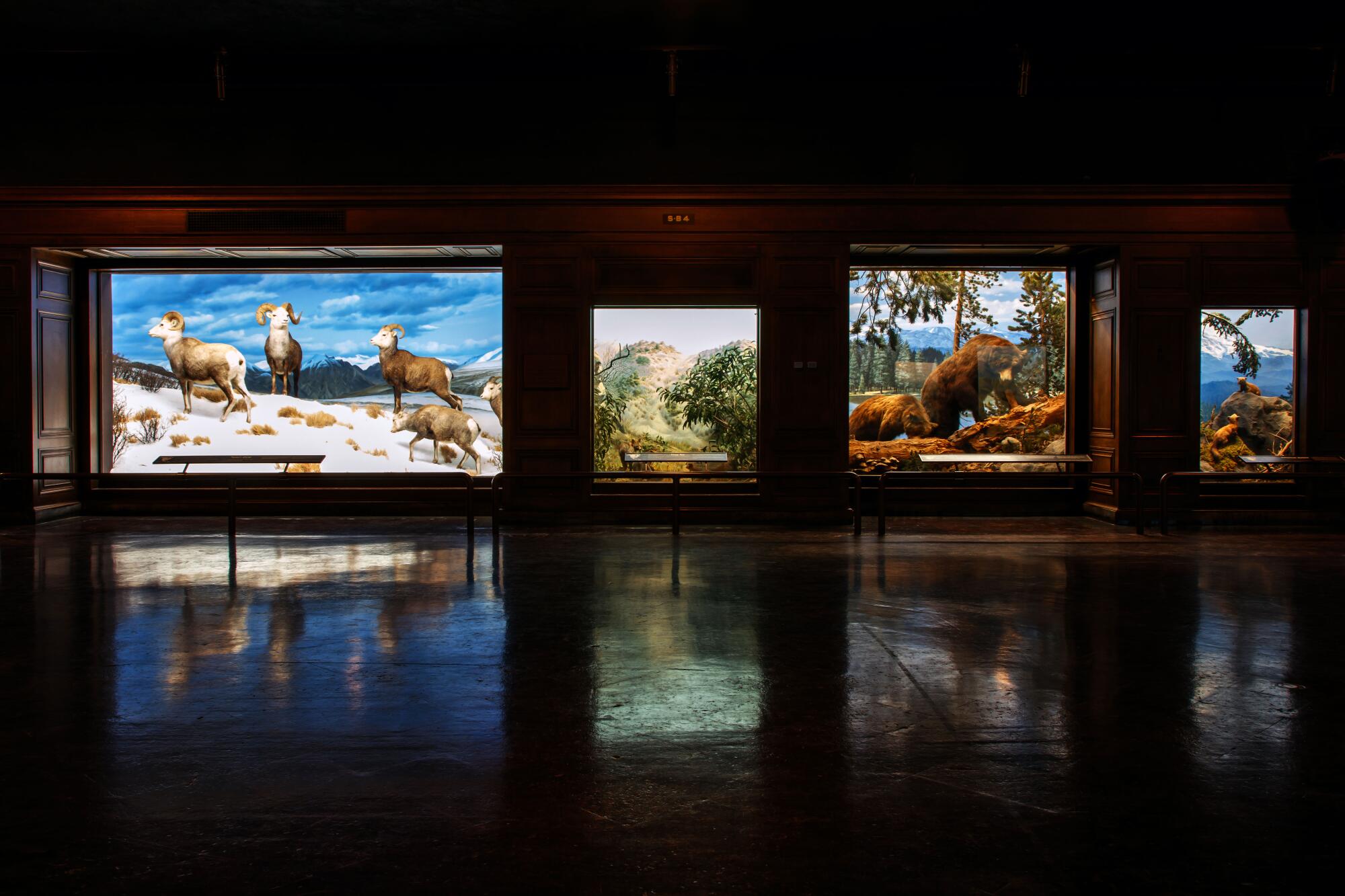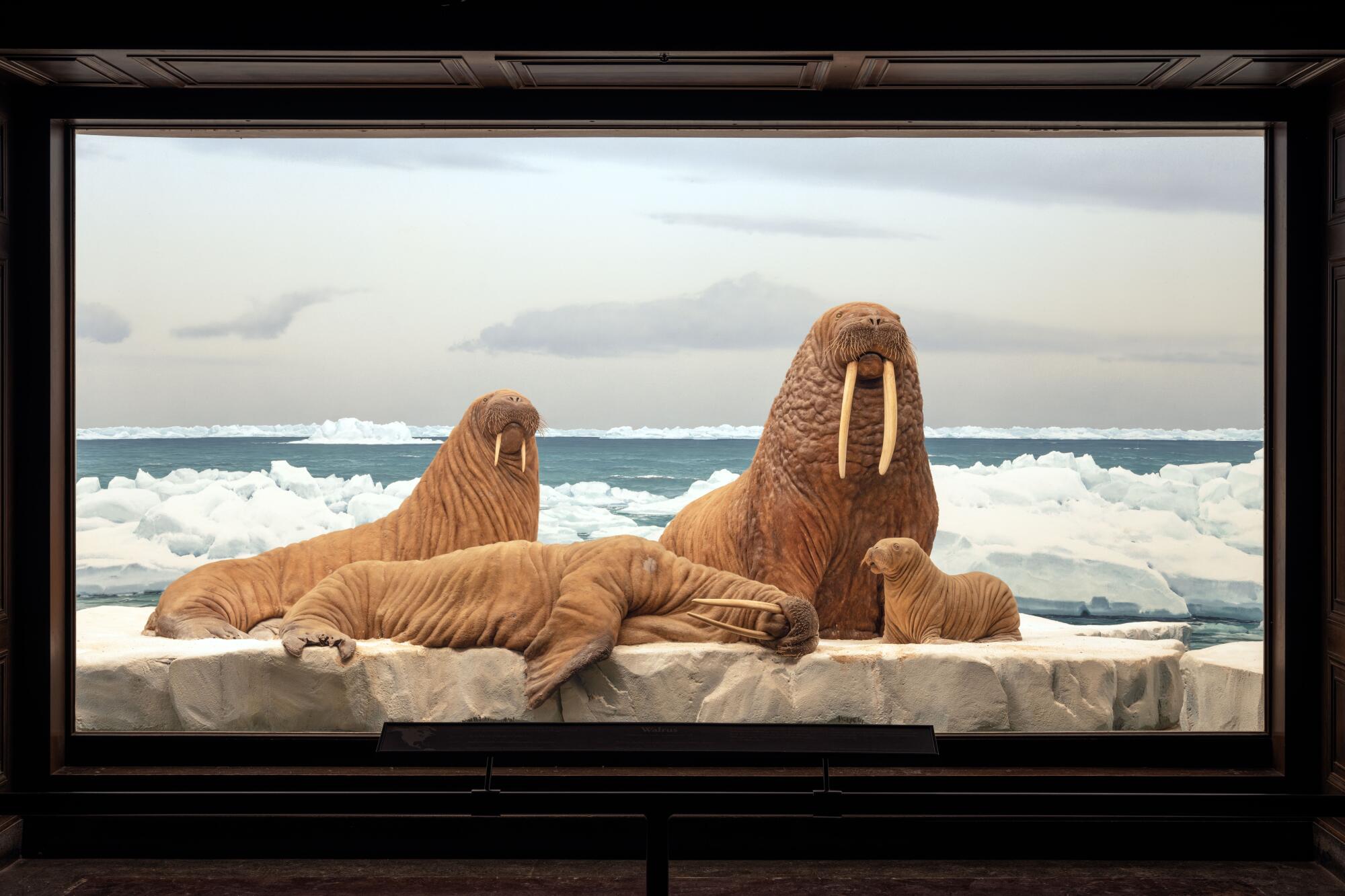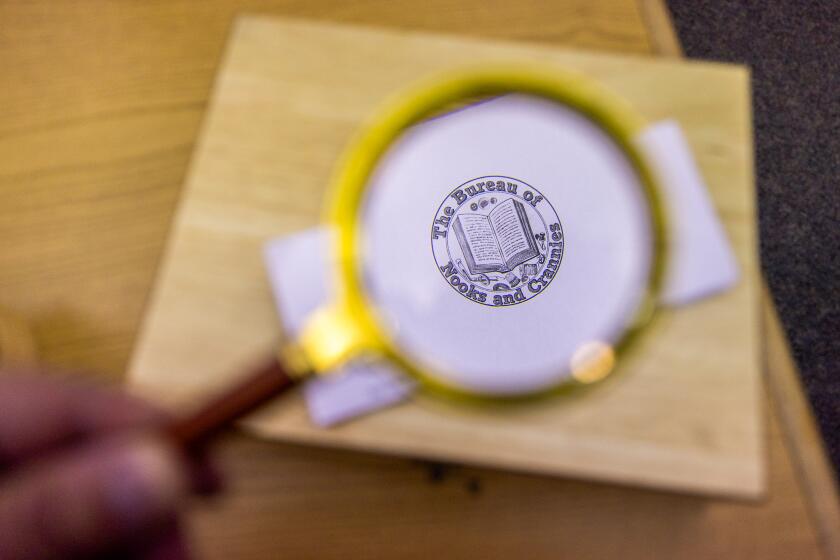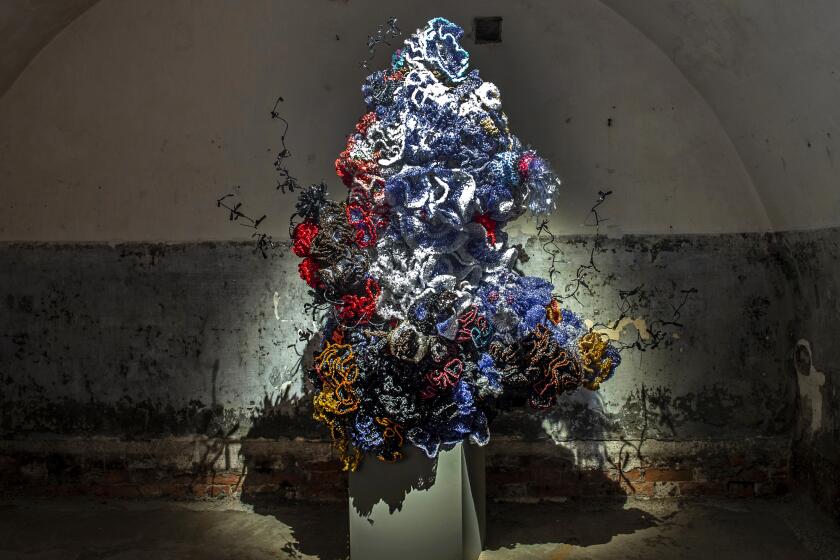
- Share via
As Sheryl Crow snarls her way through “If It Makes You Happy,” the music video for one of her most popular songs shows her trapped inside an L.A. County Museum of Natural History diorama of a simple red room wedged between a taxidermied wolf pack in the mountains on one side and polar bears on ice floes on the other. Before it’s over, we’ll see grizzly bears, moose, elephants, walruses, rhinos and more — an amalgam of the more than 75 detailed habitat displays that are at the heart of the museum’s exhibits.
In the video, streamed more than 67 million times on YouTube and still popular decades after the song won a Grammy in 1997, the tableaus glowing in the darkened diorama halls function as a metaphor of enclosure, as well as transgression, escape and freedom.
Crow wears animal-print clothes and claws comically at the camera. When visiting Boy Scouts press their faces against the diorama glass as if they were trapped inside, a girl wears braids that look like the horns of the Arabian oryx she is contemplating, and a very much alive elephant crosses from stage right, we may begin to wonder which side of the glass is holding back the wildness of nature.

The music video is a testament to the ongoing popularity of dioramas, and the way they can be appropriated for new contexts and meanings, a process that will get a boost this month as the Natural History Museum unveils three new diorama variations commissioned from artists for the citywide event PST ART: Art and Science Collide.
The boundary between reality and art is always uncertain in dioramas. In the early days, diorama creators were concerned that wild nature was disappearing. They wanted to preserve it to inform, educate and improve mankind, even if they had to send out hunting parties and specimen collectors to kill animals, uproot plants and put them all in front of a painted backdrop and behind glass to do it. Some, including the Smithsonian’s influential taxidermist William T. Hornaday, were also connected to racist ideologies concerned with preserving a “pure” white race of human beings.
Architect Frederick Fisher has worked on cultural projects that include the Getty Villa, the Huntington and MoMA PS1. Now his studio is helping refresh the Natural History Museum.
Artifice marks how dioramas are represented and understood. In the 1970s, photographer Hiroshi Sugimoto became famous for his “Dioramas” series, photographs of habitat groups, including some at the Natural History Museum, that leave out any evidence of enclosure or signage. At first glance they look like genuine wildlife photography.
Similarly, a 2012 Super Bowl Honda car commercial mashed up the real and fiction upon fiction when Matthew Broderick parodied his role in “Ferris Bueller’s Day Off.” Supposedly playing hooky from filming a movie, he visits the walrus diorama at the Natural History Museum. Broderick contemplates the walrus while the walrus watches him, evoking one of Bueller’s most-quoted pronouncements:
The game-like endeavors are designed to get guests to view their local libraries — and the world outside of them — a little more imaginatively.
“Isms, in my opinion, are not good. A person should not believe in an ism, he should believe in himself. I quote John Lennon: ‘I don’t believe in “Beatles,” I just believe in me.’ Good point there. After all, he was the Walrus. I could be the Walrus. I’d still have to bum rides off of people.”
Animals are “good to think with,” the French anthropologist Claude Lévi-Strauss famously wrote in his book on totemism. And animals in dioramas clearly can unsettle anyone’s thinking.
Representations of nature in dioramas have been influenced by traditions of landscape painting and movie backdrops, with their conventions of visual realism, compositional balance and the creation of particular moods through dark woods, looming mountains, sunny skies or threatening clouds. Interpretive labels seek to shape what people notice in the scene, the connections they make as they move from one diorama to another. Changing interpretations have, in turn, shaped what gets included in each miniature habitat.
For attentive visitors today, dioramas new and old raise endless questions.

In a 2012 episode of “Mad Men,” a girl visiting New York City’s American Museum of Natural History — filmed, in another twist on reality and representation, in L.A. — asks about the musk ox diorama, “How’d they get all these animals?” Her friend dryly responds that “Teddy Roosevelt killed them.” “Are they a family?” the girl wonders, to which her friend quips, “I hope so. Otherwise, what were they doing? Walking around saying, ‘We just need a baby to finish this diorama’?”
Sometimes, difficult but important engagement can be sparked by simply changing the wall labels that accompany dioramas. In 2018, for example, the American Museum of Natural History in New York City modified a diorama depicting an imaginary meeting between 17th century Dutch settlers and a group of Lenape Indigenous people by adding overlays to the glass that explained the ways the scene was historically inaccurate. These overlays preserved the integrity of the original diorama as an artifact and opened up conversations about its political and racial history.
Sometimes dioramas can change meaning without any overt intervention. A traditional diorama of polar bears on an ice floe hardly needs any changes in presentation or interpretation to take on new meanings in our era of climate change. The scene, a version of which was first displayed in the early decades of the museum’s 110-year history, now seems to have eerily anticipated global warming.
Thousands of Finnish crocheters recycled plastic into simulated corals for the Helsinki Biennial. Then the rain started.
New diorama designs can also open up new conversations. A diorama showing native and nonnative urban wildlife in a Los Angeles backyard — a coyote with a cat in its mouth, birds around a feeder, a rat scurrying away, the downtown skyline in the hazy distance — illustrates the relationship between human residents, domesticated animals and wild animals, all living together in close proximity. This is what ecologists call a “novel ecosystem,” a habitat shaped by both people and nature.
But these examples also hint at the limitations of dioramas, and not just in terms of content but as an art form like a painting, a sculpture or a movie.
Formally, a diorama is a single scene in a narrative or story, like one still frame in a movie or one panel in a graphic novel. Often it evokes what scholars call a masterplot, the kind of story line that dominates the way people think about things. A diorama of a pride of lions can stand in for a hunt, or for a hierarchy, reinforcing the idea of the lion king. But while it is easy to call up a masterplot with just one scene, it is much harder to disrupt or question it in such a limited display. This sticky effect can overpower labels, overlays and counterprogramming.
So creating new meaning may require new experimental and even disruptive forms of dioramas. That is why NHM has invited outside artists to experiment with new forms in the halls. Some museums have decided to do away with dioramas because their problematic meanings can be so difficult to change. But dioramas continue to attract large numbers of visitors, and their frequent appearances across various forms of popular culture attest to their continuing ability to entertain and communicate in surprising ways.
The Natural History Museum is seeking Los Angeles’ help in naming a dinosaur fossil, affectionately called ‘Gnatalie’ for now, that will go on display later this year.
Perhaps we can learn from some of the ways that dioramas are used outside of the museum to inspire innovation inside it. For starters, diorama designers of the future could experiment with more human-altered landscapes, such as the L.A. backyard scene. They might try out virtual backgrounds, sounds, smells, animation or holographs. These techniques could succeed at enlarging the narrative beyond a single scene.
In any case, dioramas should remind us that nature, even and especially at its most authentic, never comes to us as unalloyed reality. It is always filtered through layers of worldviews, social practices, historical memories and anticipations of the future.
What Lévi-Strauss concluded about totems can be applied to dioramas, too. He put thinking about nature through totems —that is, human beings comparing themselves with nonhuman beings, creating metaphors with animals and plants, speculating about differences and similarities, categorizing individuals and species — at the very origins of human intellect, language and culture.
“There is nothing archaic or remote about it,” Lévi-Strauss concluded about totemism. And we would say the same about dioramas.
Jon Christensen and Ursula K. Heise are founders of the Laboratory for Environmental Narrative Strategies in the Institute of the Environment and Sustainability at UCLA. This essay is adapted from the forthcoming book “Fabricating Wilderness: The Habitat Dioramas of the Natural History Museum of Los Angeles County.”
More to Read
A cure for the common opinion
Get thought-provoking perspectives with our weekly newsletter.
You may occasionally receive promotional content from the Los Angeles Times.










